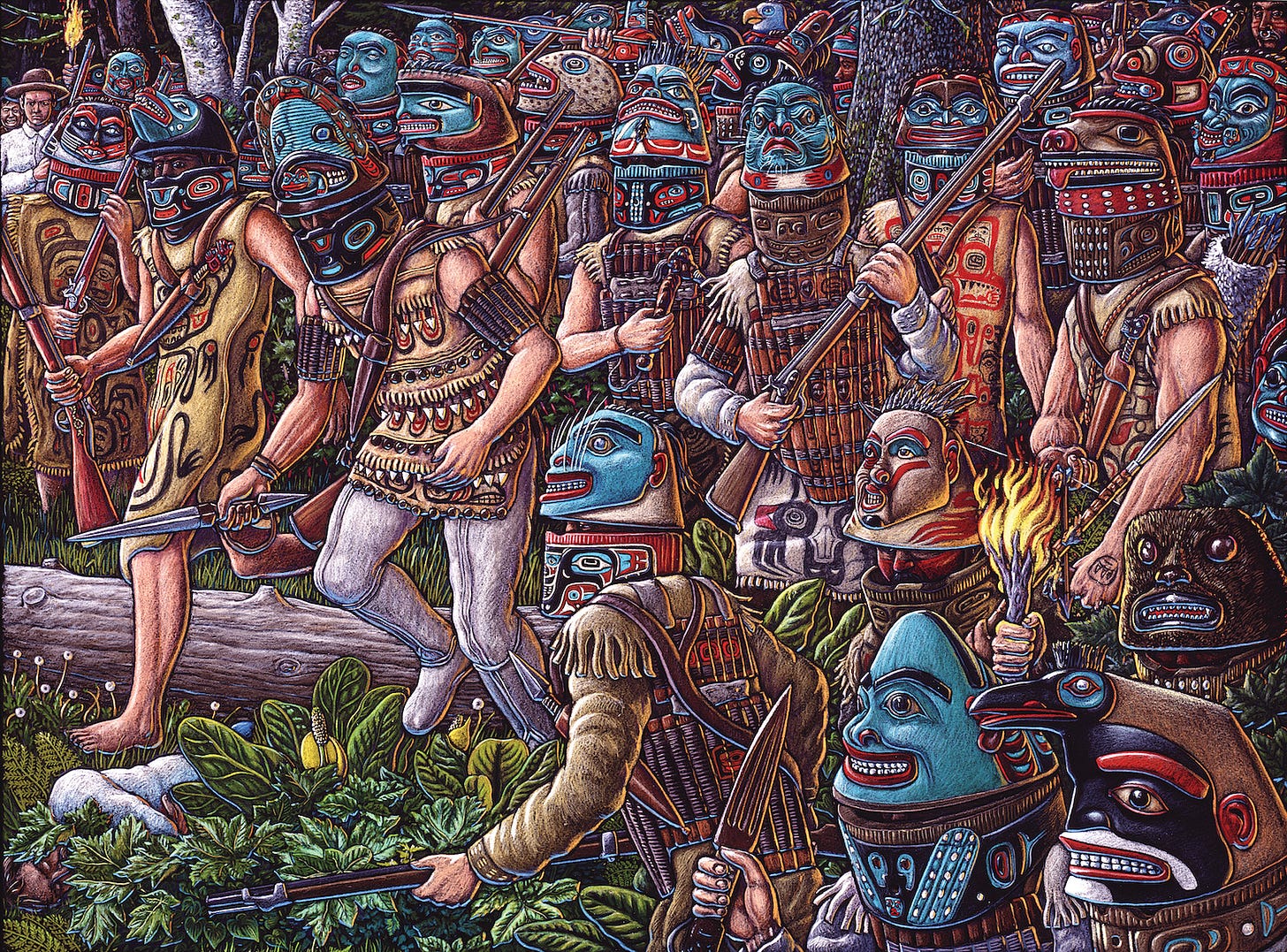An African aloha
A Kenyan cowboy evokes sounds of Hawaii. Plus a short history of Russians in the West, a type contest, and announcing a new photography collection: Animal Portraits.
FIRE
ON A SUNNY day in October, 1991, a shadow appeared over our Berkeley garden, which Barbara was tending. She looked up to see a pitch-black cloud hovering over the nearby hills. In the ensuing Oakland Firestorm, friends were forced to abandon their cars to run downhill. They lost their homes, art, and pets, and other people their lives. In the past two weeks, that numbing, bottomless grief has returned, in Los Angeles. Inside such painful tragedy, as the Greeks knew, often lies a terrible beauty. This photograph was made by our friend Lynn Robb, who lives in Santa Monica.
ON LANGUAGE
Swahili-Hawaiian Punch
A SONG ON YOUTUBE recently caught my imagination, one with a mainstream Christian message sung with an old-fashioned country twang by a cowboy. In Swahili. The Kenyan singer had a ten-gallon hat and a great set of pipes. With its Swahili lyrics, the Christian message went right past me (thankfully), but the gospel lilt came through loud and clear. And I love gospel.
It gets weirder. I listened to the song repeatedly and began to wonder: is this really Swahili? I swear it sounds Hawaiian.
I know virtually nothing of either language. I’ve been thrilled by the Hawaiian people’s successful struggle to bring their language back from the brink of obliteration. I have listened to many kinds of Hawaiian music, and have heard spoken Hawaiian in several different settings. That’s pretty much it.
My ignorance of Swahili is even greater. It’s limited to my vague familiarity with the Swahili version of the African National Congress anthem, called Mungu Ibariki Afrika. The lyrics are beautiful and the tune makes you want to sing along, unlike a certain other national anthem I know.
I checked into it and there’s no doubt the cowboy song is in Swahili. But as I listened, the similarity to Hawaiian in phonation—the sounds—became clearer. When I searched for confirmation, Google flat out rebuffed my idea. “There are no historical, grammatical or syntactical similarities between the two languages,” it scolded.
So I turned to ChatGPT. An old friend once called me an “early resistor” of technology, but Kerry got a subscription to ChatGPT when it first came out and I’ve started to use it. From time to time. Every day.
I appealed to ChatGPT to soothe my feelings over Google’s reprimand. I asked it to focus on phonological resemblances, ignoring history, grammar, and syntax. I asked specifically about the features I’d noticed: the high vowel-to-consonant ratios and an ample supply of short, repetitive syllables.
The dissertation I received (in 23 seconds, mind you) was heartwarming. Yes, it told me, Hawaiian and Swahili share an entire world of sound similarities. Both languages favor simple syllables like "ba," "ka," or "ma," making them rhythmic and easy to pronounce. For example:
Swahili: rafiki (friend), safari (journey)
Hawaiian: aloha (love, hello), ohana (family)
Both use repetition for emphasis (linguists call it “reduplication”). Hawaiians say wikiwiki for "quickly" and the Swahili say polepole for "slowly." Both avoid consonant clusters. In fact, Hawaiian disallows certain complex consonant clusters, those horrible vowel-less throat sounds that can make Polish impossible to pronounce.
And then I read, “The phonetic simplicity and high vowel ratio in both languages make them particularly accessible for non-native speakers and ideal for music. This is why both Swahili and Hawaiian songs often have a global appeal.” Hallelujah! Turns out the auditory features I’d perceived reinforce both the rhythm and melody of sung language.
Now I’m hoping my new favorite Kenyan, Maombi Samson, will spark a novel cultural trend: singing cowboys bilingual in Swahili and Hawaiian. It could go global! —Barbara Ramsey
HISTORY

The Russians have landed
MY FRIEND CHUNA McIntyre likes to return on Christmas to his village in Alaska, where celebrations are conducted inside the Russian Orthodox Church in three languages—Yup’ik (his native language), English, and Russian. I met Chuna a decade ago in Santa Rosa, where he lives, at a conference on Russian American history. It was the most boring recitation of academic papers I’ve ever attended. But his funny, lively presentation on Alaskan parkas—which he makes and curates for major museums—woke me from my nap.
The history of the American West was long dominated by the East-West story of American pioneers. More recent histories have recognized the northward cultural penetration of the mestizo South. But as Chuna’s Christmas celebrations remind us, a less well-known story originates in the Arctic North.
That story begins with migrations across the Bering Strait at least 15,000 years ago, writes a new chapter during the Russian American Company’s foray southward from Alaska in the early 1800s, and continues with a wave of Russian immigrants in the early twentieth century. By then, the West boasted over thirty Russian-language newspapers, including several in Washington around Seattle, Tacoma, and Spokane. Some were published by the Russian Orthodox church while others focused on labor and political issues popular among Russian-speaking workers in the logging, mining, and railroad industries.
This North-South story shares a mestizo cast, or in the Russian vernacular, Creole. Following the same path as the original migrants, immigrant Russians were of multiple ethnicities and cultures, and had children with indigenous Arctic people and Athabascan Alaskans from Kodiak and the Aleutian Islands, who they both indentured and employed to hunt otters and seals. When the Russians, the Alaskans, and their Creole offspring moved south to find food and new hunting grounds, they co-habited and had more children with those they met in California, particularly the Kashaya Pomo who lived near the settlement at Fort Ross on land that they called Métini. By the time the fort was sold to John Sutter in 1841, Creoles were the majority.
What is their legacy, beyond a few place names in northern California—Russian Hill, Russian River, Russian Gulch? One is tragic. The sea otters once plentiful on the Pacific coast were over-hunted and in California reduced to a small colony that hung on near Big Sur. More affirmatively, the mercantile Russians generally resisted the pattern of enslavement and conversion of Native Americans practiced by the Spanish, whose northward expansion they arguably helped stall, and of the extermination and assimilation policies later brought by the Americans.
With notable exceptions, such as the war with the Tlingit of 1802-04, the Russian American Company preferred trading to fighting. The Kashayan culture was left more intact than many, if now interlaced with Russian and Aleutian words and tools and cuisines. When Fort Ross closed, many of its Creole families went to live in Russia or Alaska. Others stayed.
The later Russian immigration to California, in the decades before and after the Bolshevik revolution, likewise did not possess a single ethnic or cultural cast. Latvians, Poles, Ukrainians, and especially Jews, escaping pogroms, joined the exodus. Many arrived at Angel Island near San Francisco, the west coast’s Ellis Island, and other locations to the north. They, too, encountered, married, and bore children with people they would have otherwise never met—a forerunner of a pattern that continues.
Some of the 19th century immigrants, such as the Russian Count betrothed to a Spanish commander’s beautiful young daughter, have celebrated stories, but many are less well known. There is the Russian serf who briefly became the slave (and later friend) of a Makah toyon, a term for a tribal chief that originated with the Yakut of Siberia. Oral tradition suggests that the toyon, Chief Dee-ah, was the Creole son of an Irish seaman left on Vancouver Island by Captain James Cook. In another story, a Russian Kamchatkan with a native mother, captured by Spaniards, fell in love with a Monterey woman and converted to Catholicism to marry her. But an Alutiiq hunter imprisoned by the Spanish died under torture rather than renounce his Russian Orthodox faith. Peter the Aleut, venerated as a martyr, subsequently became the church’s only Native American saint.
Though the 19th-century wave of “undersea people,” as the Pomo called them, formally left in 1841, their presence can still be felt in the historic buildings and artifacts at Fort Ross. Most of all, the restored Russian fort and the former immigration station at Angel Island serve to remind us of the enduring legacy in the American West of broad cultural encounter and transformation.
—Kerry Tremain
This short essay is adapted from Russian California: Hidden Stories from Fort Ross & Beyond, which I produced for the California State Parks Foundation.
PHOTOGRAPHY
Faces
ANIMAL PORTRAITS collects forty-two portraits I’ve made of mammals and birds, rendered in monochrome sepia. These photographs of individual animals were taken on farms and in a zoo, on beaches and in forests, in national parks and in my front yard. I recently became captivated by the emotional tone some animal pictures assume when converted to black and white. I began obsessively combing through six years of my archive, testing and selecting images, and then pairing them for the book. You can view the results for free online or order a signed, 48-page perfect-bound book, in limited first edition of fifty, for twenty bucks.
I’ve created two other online books this winter, both free on my web site: Animal Vegetable Mineral and Iberia. Twenty-five copies of the Mineral book are available in print. If you are interested in having one, please email me: kerry.tremain@gmail.com. You can also keep up with my latest work on Instagram.
A LITTLE [BIRD] HELP FROM OUR FRIENDS
Birds in your pocket
MY PAL Paul Aniotzbehere gave me this pocket-size book, originally copyrighted in 1913 and published by Macmillan in 1928, which he inherited from his Aunt Elvira. I’m told she was a woman of intellect and high spirits—Paul has a photograph of her and his uncle meeting with Trotsky in Mexico shortly before the Bolshevik’s demise. I particularly admire the embossed lettering and swash characters on the bird guide cover and Elvira’s cursive handwriting in a style that we all used to learn. —KT
TYPE CONTEST!
IDENTIFY the typeface or typefaces on the cover of this 1928 pocket edition. Winners will receive copies of all three of my bird photography books.











He totally sounds Hawaiian. Dumb google. Smart Bar-Bar
The animal portraits are absolutely luminous and revealing. Perhaps I am anthropomorphizing, but the personalities truly shine. Can't wait to get my copy!
Really enjoyed the music, too! The universality of feeling in music gives joy - of which we are sadly in need of more than ever. Thanks, Barbara.